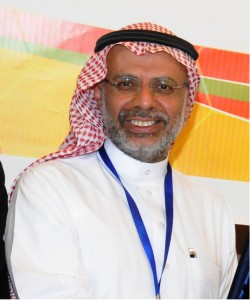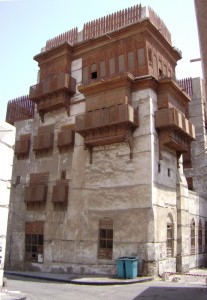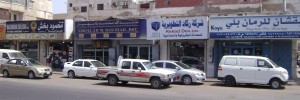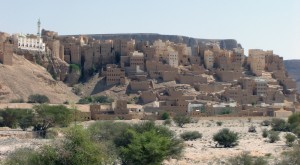Pursuing my ongoing quest for members of the Hadrami diaspora in the Indian Ocean, last month I visited Saudi Arabia. There is, and has been for many decades, a substantial and important community of Hadramis in the country, and particularly in the towns of the Hejaz: Mecca and, above all, Jeddah, where those who had the wherewithal settled as traders and those who didn’t found themselves jobs, much as in East Africa. Unlike Hadramis in East Africa, however, there was no significant religious element to Hadrami migrations to the Hejaz (coals to Newcastle), although Hadramis—from all over the Indian Ocean—certainly came to study here, in both Mecca and Medina.
The Hadrami presence in Saudi Arabia easily predates the oil boom: indeed, many of the old, established families were in Jeddah long before before the creation of the country by Ibn Saud in 1932, trading across the Red Sea, to Hadramawt and across the Indian Ocean, and making a comfortable living selling provisions and services to pilgrims performing the Hajj. The pilgrimage to Mecca is one of the five pillars of Islam, an obligation incumbent upon all Muslims who can afford it, and Jeddah is the gateway to Mecca for those arriving by sea, as many did: it was a captive market, as such places are.
The Hadrami reputation
Hadramis are renowned not only for their business acumen but for their personal characteristics: they have a reputation for being honest, trustworthy, ingenuous and hardworking.
In the early years of Saudi Arabia, King Abdulaziz Ibn Saud relied on Hadramis to construct his new kingdom: Salim bin Mafouzh (founder of the National Commercial Bank) lent him money and Mohammed bin Laden (founder of the Saudi Binladin Group) built his palaces, or so the story goes. Regardless of the myths, Hadramis in Jeddah, and in Saudi Arabia generally, were both successful and very highly regarded, particularly by the Saudi royal family, and were trusted servants, often working as household treasurers for members of the wealthy Saudi families.
In addition to their personal qualities, Hadramis are recognised to be supportive of one another and intensely proud of their identity. Indeed, their identity is often carefully maintained. Fathers would regularly return to Hadramawt, taking their children with them so that they could see the beauty of their homeland and learn its customs and culture. In Saudi Arabia, they ate Hadrami food and made sure their children used the correct Hadrami vernacular: “Don’t call me abuya, call me aba,” one man’s recalls his father admonishing him: “If I called him abuya he would hit me.” Abuya is the Saudi term for “father”, aba is Hadrami. Children were encouraged to speak with Hadrami accents and, when they were of age, to return to Hadramawt to find a wife, preferably from the same family and the home village.
Community and flexible immigration rules
Hadramawt is today part of the Republic of Yemen, but it was not always thus. Prior to independence Hadramawt was divided into two sultanates, the Kathiri and the Qu’aiti, which were part of the British East Aden Protectorate. In 1967, when Aden and the Western Protectorate were granted independence, the sultans were deposed and Hadramawt was forcibly incorporated into the socialist, later Marxist, People's Democratic Republic of Yemen, or South Yemen.
Until the 1960s, there were few restrictions on movements from Hadramawt into Saudi Arabia, and Hadramis born in Saudi Arabia acquired Saudi citizenship. As the Saudi economy grew immigration controls were gradually imposed but Hadramis, by virtue both of the high esteem in which they were held by the Saudi royal family and of Saudi policies welcoming Hadramis fleeing the communist regime in South Yemen, were treated leniently. In particular, the requirement that foreigners be sponsored by a Saudi citizen—an essential condition for the granting of a residence permit—was flexible. Whereas most foreigners were (and remain) required to be sponsored by an employer, and change sponsors when changing jobs, Hadramis were permitted to be sponsored by an individual or company who would simply vouch for them. They could then find jobs as they chose, and many worked for older Hadrami families who, as Saudi citizenship, owned their own businesses.
As a result, prominent Saudi citizens of Hadrami origin, of whom there are many in the kingdom, would sponsor large numbers of their fellow countrymen. This strategy was possible largely as a result of the highly cohesive character of Hadrami society: misbehaviour on the part of a sponsored Hadrami would have wide social repercussions. This, incidentally, explains why, when Yemeni support for Saddam Hussein during the Gulf War led to the extension of sponsorship requirements to Yemenis (who had hitherto been exempt from immigration controls), there was a mass return of Northern Yemenis to Yemen while Hadramis (who were also now Yemenis following the unification of the two Yemens a few months earlier) were able to stay: the strength of Hadrami networks was such that it was a relatively straightforward matter for Hadramis to find individual sponsors, Saudis of Hadrami origin, to put their papers in order. Northern Yemenis did not have such networks.
During the Marxist period in South Yemen few Hadramis were able to visit their homeland. Those who were Saudi citizens had trouble obtaining visas while those who had South Yemeni papers feared not being able to leave again: some were even imprisoned for their reactionary Saudi links. Following unification restrictions were relaxed. In the intervening twenty years the older generation had maintained contact with family members in the ancestral villages but many of the younger generation, Saudi born, had no direct experience of the homeland. Through the cohesion of the Hadrami community and the inculcation of Hadrami values by their parents, however, there was nevertheless a general awareness of their own culture.
Shaykh Abdullah Bugshan and the creation of diaspora
Among the Hadrami businessmen who had sponsored Hadramis were Ahmed Salim Bugshan and his son, Abdullah: Hadramis remember how the Bugshan family sponsored hundreds of them. Ahmed Salim founded Saudi Bugshan in the 1920s and the company, one of the largest in Saudi Arabia, now has interests in the automotive sector, real estate, telecommunications and cosmetics and perfumes. As a Hadrami he took his son back to Hadramawt as a child, and Abdullah married a Hadrami woman.

Saudi Hadrami businessman Abdullah Bugshan”, source: http://news.ksu.edu.sa/news/34554
In 2002, following the successful negotiation of the Saudi-Yemeni border and the normalisation of relations, Shaykh Abdullah Bugshan made his first return visit to Hadramawt for more than 30 years. Dismayed by the lack of infrastructure, and by the poverty, in the region from which his family came, Wadi Duan, he began investing, funding road construction, electrification of the villages, youth activities, education and health. He now runs a number of programs engaged in charitable work in Hadramawt; particularly noteworthy is his investment in education and the provision of scholarships for Hadramis. And he is also investing commercially, of course.
However, there is also a cultural aspect to his activities as he shares his enthusiasm for his homeland. On his first visits to Hadramawt in the early 2000s he was accompanied by friends, some of whom had never been before. Since then he has drawn on Hadrami networks in Saudi Arabia, both through personal connections and through more contemporary networks, such as Bilad al Hadramawt, a Riyadh-based group that of course has a Facebook page, and organises visits by Hadramis, young and old, to their homeland. Twice a month his private jet makes the round trip to Hadramawt, usually for the weekend, where he provides accommodation and cars to transport his guests from site to site.
The older generation, who may have been born in Hadramawt but not had the opportunity to return, or whose fathers insisted on the transmission of Hadrami identity and insisted on the importance of Hadrami social values and cultural practice, return, almost without exception, suitably enthusiastic about their refreshed identity.
The younger generation, however, seem to be more ambivalent. Some are similarly enthusiastic, others appear to be somewhat bemused about the matter. “It was interesting,” one young man, Saudi born, told me, “it was a nice holiday, but I probably wouldn’t go back”. Nevertheless, he did say he met others like him on the trip, and although he hasn’t kept in touch he says he knows who they are now. This may pave the way for further links to be established within the diaspora.
I have yet to meet people who refuse to join Sh. Abdullah’s Hadramawt visits, but there are certain to be some. Diasporic discourses include both expressions of inclusion and exclusion: the young in particular (and this is not surprising) are often reluctant to accept Hadrami identities. One young woman told me how some of her Hadrami Saudi friends at school wanted to change their names, dropping the Ba prefix which is typically Hadrami, thus removing visible evidence of their ancestry and affirming their Saudi identities.
Sh. Abdullah’s diaspora identity construction activities are fascinating. He is famed for his enthusiasm for all things Hadrami. I first heard his name in Hadramawt in 2006, where his charitable activities—particularly in the fields of education and health—are common knowledge and although there are critics, he is generally well regarded for his activities. His support for the Hadrami community in Saudi Arabia is also common knowledge and it is clear that he is one of the driving forces behind the maintenance of Hadrami identity in the country. The fact that he promotes diasporic identity draws attention to Hadramis and even the reluctant feel the effects: their identity as Hadrami is now, in part, inscribed within the activities of Sh Abdullah.
For those who are enthusiastic, there is invariably a seat on his plane, and many make regular visits. People return to the villages of their ancestors and even if they visit as “tourists”, the experience prompts a feeling of solidarity with others in Saudi Arabia. Social networks develop and are reinforced, Facebook pages are active, people meet socially and establish professional relationships. In the wider Saudi community many are aware of these activities and the existence of a community of Hadrami origin, and so Hadrami identity coalesces. So the question is: can you construct a diaspora? If you have enough money, the answer may be yes.


